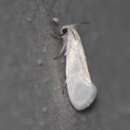Conservation Status
provided by University of Alberta Museums
The Yucca Moth is threatened in Canada (COSEWIC 2002).
- license
- cc-by-nc
- copyright
- University of Alberta Museums
Cyclicity
provided by University of Alberta Museums
Adults fly from early June to mid-July, with a few individuals appearing in August in Alberta.
- license
- cc-by-nc
- copyright
- University of Alberta Museums
Distribution
provided by University of Alberta Museums
Limited in Alberta to the southeast corner along south-facing coulee slopes of the Lost River, Milk River and adjacent coulees. Occurs south to Texas and Florida, north to southern Ontario, where it may have been introduced along with Yucca filamentosa, which is not native to Canada (Pellmyr 1999).
- license
- cc-by-nc
- copyright
- University of Alberta Museums
General Description
provided by University of Alberta Museums
Wingspan 19.5-27.5 mm in females, 18-24 mm in males; forewings white dorsally, underside mostly dark brown; hindwing brownish gray, dorsally, light brown ventrally (Pellmyr 1999). Head white, antennae and proboscis yellow; females with specialized maxillary tentacles arising from the base of each maxillary palpus; these are tubular and membraneous with numerous short, hooked hairs scattered on the inner surfaces which help retain pollen (Pellmyr 2000).Thorax white, legs yellow; Abdomen pale brown dorsally, ventrum white (Pellmyr 1999). When the female ovipositor is withdrawn, the tip of the abdomen is truncate, and the terminal joint bluntly rounded at tip with a corrugated ridge dorsally before the tip (Riley 1892). Pupa with acute spine on head and spines on back (Riley 1892). Larvae less than 1 mm when newly hatched, 14 mm at maturity; at first translucent white but turning yellowish, then reddish; no pro-legs but thoracic legs developed; undergoes three moults (Riley 1892). Egg thread-like; about 2 mm in length (Riley 1892).
- license
- cc-by-nc
- copyright
- University of Alberta Museums
Habitat
provided by University of Alberta Museums
In Alberta, found in dry grassland on south-facing coulee slopes of the Milk River basin.
- license
- cc-by-nc
- copyright
- University of Alberta Museums
Life Cycle
provided by University of Alberta Museums
"T. yuccasella actively pollinates its host yucca plants. Females rake their specialized maxillary tentacles across anthers, then use the tentacles and forelegs to compact the pollen and store it under the head. The pollen ball is as large as three times the size of the head (Riley 1892). Figure 23 shows a female with pollen ball. Before pollinating, females oviposit in Yucca flowers (Pellmyr 1999). Larvae hatch in about one week. They consume developing seeds for several weeks. When seed pods ready to dehisce the larvae bores out, falls to ground, bores several centimeters below the surface, and forms a silken cocoon intermixed with soil. This is the overwintering stage (Pellmyr 1999). Adults are inactive during the day, and are cryptically coloured on the flowers they rest. They become active at dusk: males fly about in search of mates, while females tend to stay on a plant. Activity slows after two to four hours (Pellmyr 1999).
The yucca moths colonized Yucca plants between 30 and 50 million years ago, and began a period of rapid diversification. Active pollination evolved first, followed by the evolution of 'cheating' behaviour seen in Prodoxus, where moths do not pollinate their hosts but continue to oviposit in them (Pellmyr & Leebens-Mack 1999).
Historically, three species of Tegeticula have been recognized, including yuccasella. The species yuccasella was thought to be a single, variable species, but several authors have suggested that yuccasella is actually a species complex (Miles 1983). In 1999, Pellmyr (1999) redescribed the species and twelve additional species that are part of this complex. T. yuccasella is the only species known to occur in Alberta."
- license
- cc-by-nc
- copyright
- University of Alberta Museums
Trophic Strategy
provided by University of Alberta Museums
In Alberta, the larval hostplant is soapweed (Agavaceae: Yucca glauca). Other Yucca species are also used elsewhere (Pellmyr 1999).
- license
- cc-by-nc
- copyright
- University of Alberta Museums
Tegeticula yuccasella
provided by wikipedia EN
Tegeticula yuccasella, the yucca moth, is a moth of the family Prodoxidae. The species was first described by Charles Valentine Riley in 1872.[1] It can be found in North America from Texas to southern Canada.
The wingspan is 18–27 mm. The forewings are wide and blunt, usually white but occasionally with more or less tan. The hindwings are medium to light brownish gray.[2]
The larvae feed on Yucca filamentosa, Yucca smalliana, Yucca flaccida, Yucca glauca, Yucca arkansana, Yucca constricta, Yucca rupicola, Yucca pallida, Yucca reverchoni and Yucca aloifolia. They feed on developing seeds. Pupation takes place in a cocoon in the soil.
References

- license
- cc-by-sa-3.0
- copyright
- Wikipedia authors and editors
Tegeticula yuccasella: Brief Summary
provided by wikipedia EN
Tegeticula yuccasella, the yucca moth, is a moth of the family Prodoxidae. The species was first described by Charles Valentine Riley in 1872. It can be found in North America from Texas to southern Canada.
The wingspan is 18–27 mm. The forewings are wide and blunt, usually white but occasionally with more or less tan. The hindwings are medium to light brownish gray.
The larvae feed on Yucca filamentosa, Yucca smalliana, Yucca flaccida, Yucca glauca, Yucca arkansana, Yucca constricta, Yucca rupicola, Yucca pallida, Yucca reverchoni and Yucca aloifolia. They feed on developing seeds. Pupation takes place in a cocoon in the soil.
- license
- cc-by-sa-3.0
- copyright
- Wikipedia authors and editors

